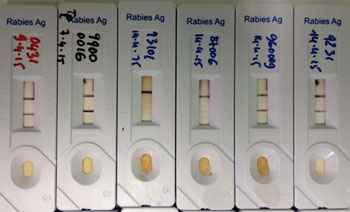Rapid Rabies Diagnostic Tool Validated for Field Surveillance
By LabMedica International staff writers
Posted on 16 Nov 2016
Rabies is a viral zoonotic encephalomyelitis transmitted to humans after exposure to infected mammals, mainly dogs, through bites, scratches or licks on damaged skin or mucous membranes.Posted on 16 Nov 2016
The high fatality and burden of rabies stands in contrast to the very low performance of laboratory-based surveillance in resource-challenged countries. The absence of reliable human and animal rabies incidence data ultimately result in neglect of disease prevention and control and the perpetuation of rabies virus (RABV) transmission despite the existence of powerful management tools.

Image: The results from the rapid immunodiagnostic test (RIDT Ag) for rabies (Photo courtesy of the Swiss Tropical and Public Health Institute).
An international team of scientists led by those at the Swiss Tropical and Public Health Institute (Basel, Switzerland) tested 48 samples from dogs and in the reference laboratory setting, a total of 73 samples was tested, representing a wide diversity of RABV in terms of animal species tested (13 different species), geographical origin of isolates with special emphasis on Africa, and different phylogenetic clades.
The team evaluated a rapid immunodiagnostic test (RIDT) in comparison with the standard fluorescent antibody test (FAT) and confirmed the detection of the viral ribonucleic acid (RNA) by real time reverse transcription polymerase chain reaction (RT-qPCR). The RIDT Anigen test, was a chromatographic immunoassay-based on lateral flow technology (BioNote, Inc, Hwaseong, Republic of Korea). Viral RNA detection was performed using a one-step dual combine pan-lyssavirus RT-qPCR assay.
The scientists reported that for the majority of the total sample size of 121 samples tested, the RIDT was successfully performed, with the presence of a line clearly visible in the control zone after five to 15 minutes of migration once the sample was deposited. Compared to the gold standard FAT, the RIDT demonstrated an accordance of 95%. The specificity was 93.3% with only two false positive results among the 30 FAT negative specimens. A total of 51 samples were tested for viral RNA detection using RT-qPCR on the Anigen test strip, which were previously found positive for the post-mortem diagnosis of rabies. When compared to the FAT Whatman card, RT-qPCR performed on the Anigen test strip exhibited a sensitivity of 80.6%.
The authors concluded that the RIDT shows excellent performance qualities both in regard to user friendliness and reliability of the result. In addition, the test cassettes can be used as a vehicle to ship viral RNA to reference laboratories for further laboratory confirmation of the diagnosis and for epidemiological investigations using nucleotide sequencing. The potential for satisfactory use in remote locations is therefore very high to improve the global knowledge of rabies epidemiology. The study was published on October 5, 2016, in the journal Public Library of Science Neglected Tropical Diseases.
Related Links:
Swiss Tropical and Public Health Institute
BioNote














